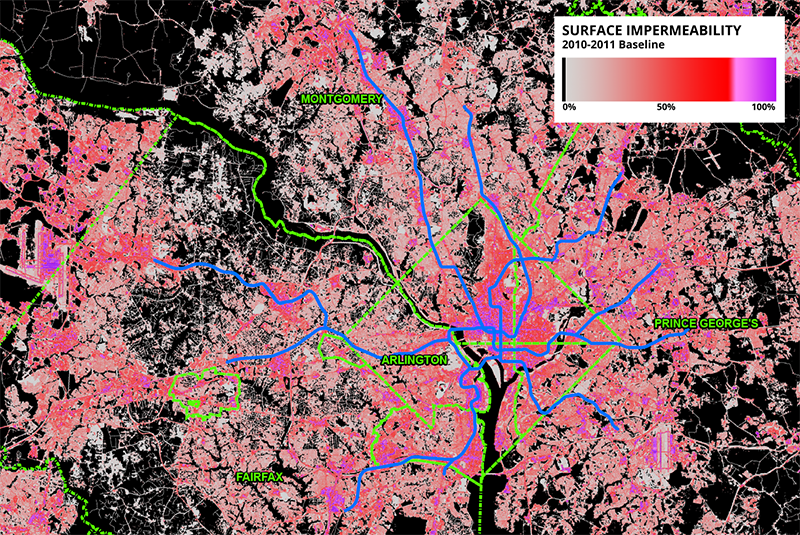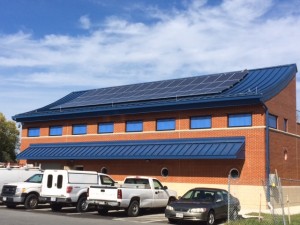Better urban planning can help save our rivers and the Chesapeake Bay—by reducing this region’s future impervious surfaces by 20%. Here’s why.
As many Washingtonians know, the Chesapeake Bay needs help. Dead zones and algae blooms appear every summer which destroy aquatic life in the Bay and threaten fishing, swimming, and economic health. A major contributor to this problem is rainwater runoff from paved roads, parking lots, and roofs. These are called “impermeable surfaces”. In contrast, permeable (or pervious) surface is one through which liquids are able to pass.
Grassy fields, woodlands and farmlands are excellent examples of this: rainwater or snowmelt soaks into the ground, pollutants in the water are filtered naturally, and excess water travels underground to streams and eventually (in the Washington region) the Chesapeake Bay.Rainfall that falls on impervious surfaces like paved roads, parking lots and roofs “runs off” unfiltered making its way to the Chesapeake Bay—along with nitrogen and sulfur oxides from vehicle emissions, motor oil, and road salt residue.

Figure 1 – Map of impermeability throughout the region with overlaid jurisdictional boundaries and Metrorail system for reference. Note the concentrations of highly-impermeable surfaces in central D.C., and at other activity centers like Dulles.
Read more…
Categories: Sustainability Tags: Chesapeake Bay, forecasts, landuse, open space, permeability, planning, stormwater, sustainability, transit, transit-oriented development, visualization, water and stormwater

Largo Stormwater Treatment Facility
Metro’s new Largo stormwater facility is making progress towards the Authority’s sustainability goals including reduced water and energy use, carbon emissions, and operating costs.
On November 13, Metro hosted a tour of its high-efficiency stormwater treatment facility at Largo. Highlighted during its design phase in a previous post on Metro’s Sustainability Agenda. The facility is now fully functional – with a green roof and solar panels that create enough energy to run the plant round the clock. “With a truly innovative design, this facility provides a green and cost effective model for organizations in the region as they make investments in similar facilities” according to Metro’s sustainability manager, Rachel Healy. The open house provided an opportunity for interested regional stakeholders to tour all of the facilities uniquely practical design in operation. Representatives from the Metropolitan Washington Council of Governments, Maryland Department of the Environment, Environmental Protection Agency, and Prince George’s County Council were in attendance.
Designed to ensure Metro meets stricter new discharge permit requirements that form part of the Chesapeake Bay Preservation Act, the facility pumps an estimated 27,000 gallons of water per day from Metrorail tunnels near the Largo Town Center Station. The new state of the art facility houses a unique combination of features designed to reduce energy consumption and continue Metro’s commitment to invest in sustainability and reduce operating costs.
Instead of using more traditional heavy duty water pumps that have a high energy consumption and operating cost, the new Largo facility features a combination of gravity-fed treatment tanks and a high-efficiency mixing system that uses bubbles of compressed air to “circulate” the water. On the roof, solar panels supply extra electricity back to grid during the day and the building only draws grid power at night or during extended periods of low sunlight. Metro will prevent an estimated 3 tons of C02 emissions per year through solar energy generation alone. This is the equivalent of half the emissions from an average homes electric use over the same period.
The Largo treatment facility showcases the dedication of Metro’s engineers and design staff in developing what is truly a cutting edge facility to meet State requirements and deliver ongoing operating savings for the Authority. Check out Metro’s video of the project and let us know what you think.




Recent Comments